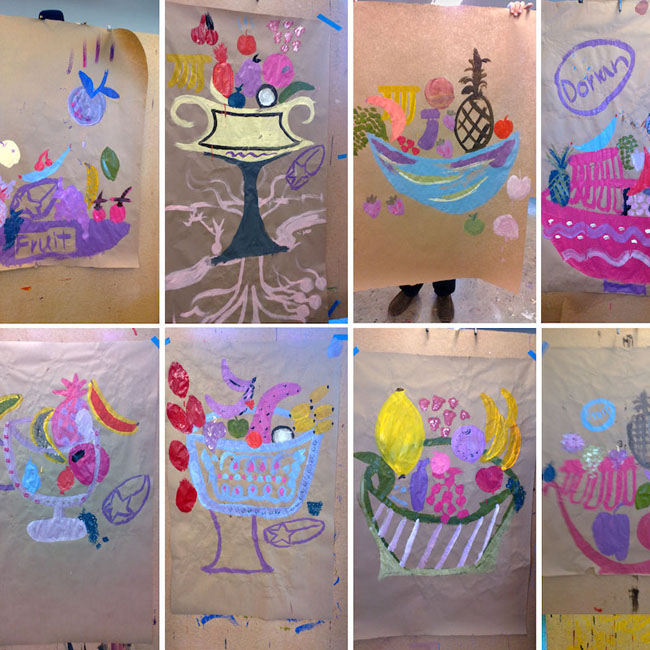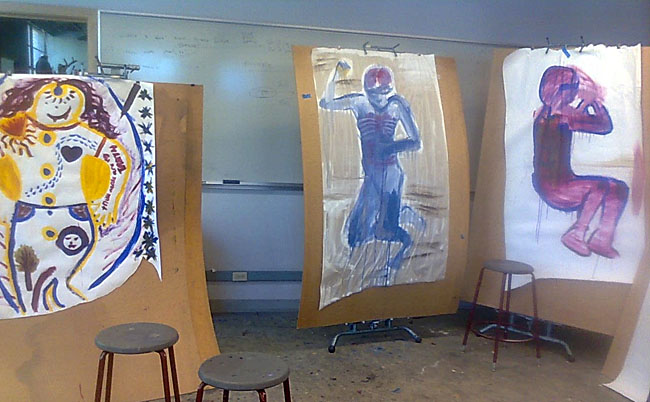
At the Seattle Art Museum
Experience Painting Project, 2008–

At the Seattle Art Museum
This workshop will lead you through a series of short kinesthetic exercises exploring the pleasure of moving paint around on large surfaces, mixing colors, using your body as a mark-making tool and enjoying working with others. We will emphasize body awareness, suspending judgment and worry, embracing mistakes, relaxation and flow. Where does your creative expression productively meet others in the context of community? This workshop is appropriate for anyone with any amount of experience. Wear paint-friendly clothing.
We’ll be doing a series of simple exercises designed for you to experience painting. Some are more like games than anything else. There is no way to fail at these or do them wrong. We’ll be focusing on painting as a verb and a process. We will practice achieving a certain state of mind—rather than try to produce any “paintings.” In fact, everything we do today will end up in the recycling bin.
As you do these exercises: Don’t think too much. Move your whole body. Be aware of your body in space. The mark your brush is making is a trace, an extension of the kinetics of your body – gravity and the ways you move against it. This line is coming from your body.
Try to remain in the moment, not anticipating where the line goes next or reflecting on where it has been. Focus tightly in at the point where your brush is touching the paper.
Although many of these exercises are simple, they are not necessarily easy. They require concentration and a willingness to put your ego in the backseat. If you find yourself losing focus, don’t worry, this will happen to everyone. Acknowledge that you have drifted without judgement and nudge your mind back into the present moment.
You might also want plastic sheeting to cover the walls/floors if you are using a space where paint splatters are a concern.
The goal is to have enough wall space for everyone to be able to tape up their 3' or 4' -wide piece of paper to work on, and not feel inhibited if they drip or otherwise make a mess.
These all are done on butcher paper cut to approximately the height of the person, and hung on the wall in portrait orientation. Each exercise uses a fresh sheet, unless otherwise noted.
1. Taking a line for a walk
This simple exercise is inspired by Paul Klee’s curriculum for the Bauhaus.
Start anywhere on the paper and make a continuous line that wanders wherever it wants to go.
Go anywhere. Fast or slow. It’s up to you.
Use your body. It’s okay to reload your brush when you run out of paint. Resume where you left off. Think of reloading your brush as a kind of breathing.
Use a loaded juicy brush.
Choose any one color you like, straight from the jug.
Suspend judgment—avoid thinking about the whole.
Practice being in the moment, not anticipating where the line goes next or reflecting on where it has been.
No gestalt.
Enjoy the sensual experiences of painting: smearing beautifully colored semi-liquid substances on a flat surface.
drips – ok
mistakes – ok
ugliness – ok
Relax and enjoy.
Painting is sensuous.
Painting is physical.
Painting is funny.
Take a deep breath before you start.
We’re going to do this for 4 min.
After each exercise, it’s nice to leave a few moments for people to step back and look at what they’ve done, and to look around at what other people have done.
2. Taking someone else’s line for a walk
Stand in front of someone else’s ‘taking a line for a walk’. Trace their line using a different color than they used. Try to figure out where they started. (Don’t ask them.) There is some aspect of this that is decoding or un-puzzling. How did they make that mark? What was their bodying doing to produce it? How fast or slow were they going? As you work, continue to practice all the mental things we’ve talked about.
This is an exercise of trying to partially inhabit someone else’s subjectivity via a trace of their body.
You can trace directly over their line or go alongside it, whichever you prefer.
We’re going to do this for about 4 min.
3. Two people taking a line for a walk.
Pair up with someone else. Be sure to have two different colors.
This is the same exercise as #1, but now you are both taking your line for a walk on the same piece of paper.
You have your own body and someone else’s to consider. This is a duet dance dictated by where your lines want to go.
We’re going to do this for about 4 min.
4. Three person braided walk
Get into groups of three, each person with a different color. Each group has a little larger paper (maybe 8-10 feet long) and hangs them portrait orientation.
The goal here is for the three of you to talk a line for a walk but this time the line is a braid of your three lines.
It’s okay to talk in your group during this one if you want to strategize or coordinate. It’s okay if you don’t want to talk too.
BREAK
This is often a good moment to take a break for 10 minutes or so. Providing something sweet to drink or eat is nice, if you can.
Whenever I teach these, I usually do #1-4 in order. Then, there are many variations to choose from, according to how you and the group are inclined. Some of these were invented by students at UCSD, Seattle University, University of Washington and the University Child Development School, Seattle.
Variations on two people taking a line for a walk. 1) Your lines can’t touch. 2) Your lines can’t touch, and one person is assigned to be a “blocker”, the other person tries to evade the blocks. 3) Follow the leader (trade-off who is leading). 4) One or both people blindfolded. 5) &etc.
Bi-lateral taking a line for a walk. Use two hands at the same time, a brush with different color in each hand.
Alternate hand walk. This is simply taking a line for a walk with the other hand than the one you used in #1.
Dots and boxes. Play this two person territory game (Look it up in Wikipedia) on your large sheet of paper with two different color paints. Fill in the boxes with your color when you enclose them. (There are a lot of other kinds of paper-based territorial games that can be adapted to these materials.)
Race to last place. Set-up is like #4 braided walk. Everyone start at one end and make a continuous line to end up at the far end. It’s a race—to be in last place.
Thesis, antithesis , synthesis. In groups of three, each person has a different color. First person makes a mark. The second person responds with another mark. The third person makes a mark that tries to somehow bring together the first two marks. Rotate roles.
Round robin rounds. Everyone starts with their own paper and free paints for 3 min. One color & however they want to make marks, still trying to practice the things we’ve been talking about. Then, everyone rotates to the adjacent paper and paints there for 3 min. Repeat until everyone’s worked on each paper. This works best if you don’t tell people they will rotate at first.
Paint as a non-human animal. Try to inhabit the body of a non-human animal. How / what kinds of marks would it make?
Ouija painting. Get in pairs and take a line for a walk, but this time with two hands on one brush. No talking.
Your signature. Take a line for a walk and see if you can nudge it into shapes that spell out your name.
Mind control. In pairs. One person has paintbrush and is blindfolded. The other stands behind them and verbally directs them as they paint.
X-ray bodies. Put paper on the floor. In pairs, take turns lying down and tracing each other’s outlines with pencil. Put paper on wall and everyone paints their “insides”, however metaphorically or literally they want to take it.
The Fruit Basket. A variation of the round robin: the first person paints a basket or bowl of some kind and each subsequent person adds some sort of “fruit”.
Invent your own. Depending on how much time you have, after students have done several of these exercise, you might want to ask them to generate their own short exercises. Have them write ideas down and pull them out of a hat for everyone to try.
People are always curious what others have done. Leave a little time for everyone to look around after each exercise. Although not necessary, it can be fruitful to have short discussions after an exercise, depending on the group objectives. Steer the group away from making aesthetic judgments (i.e., “that’s beautiful”) and focus on process. How did it feel to do this exercise? What were the challenges? What worked out and didn’t work out? What are some words you would use to describe these marks? In pair and group exercises, these discussions will often get into interpersonal and group dynamics.
Revised January 2020
Seattle

fruit basket

x-ray bodies